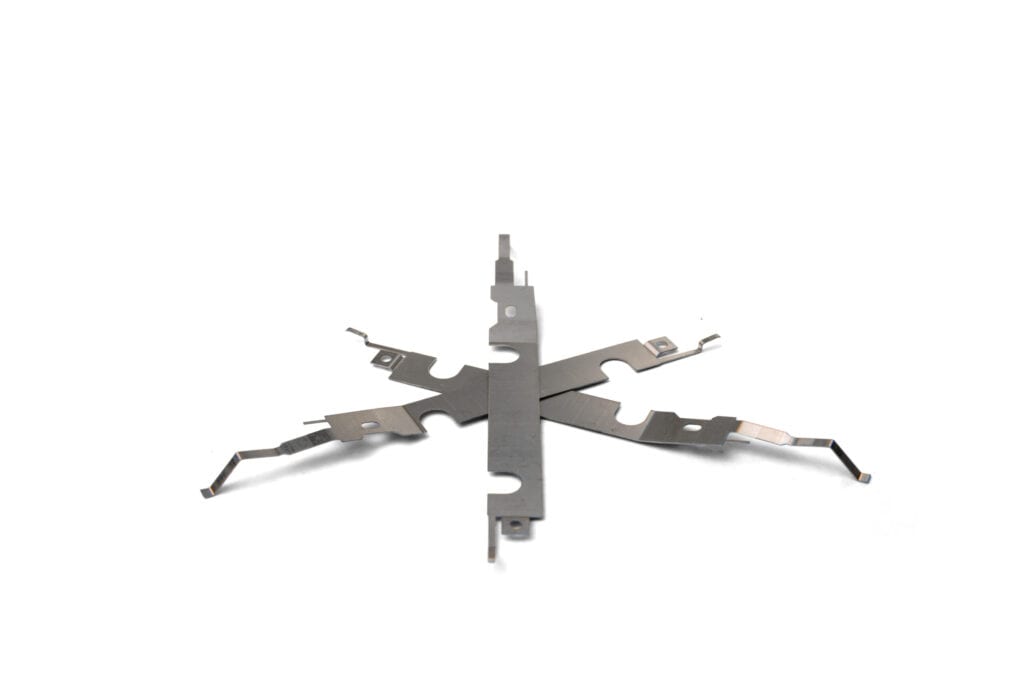Choosing the Right Option for Your Next Stamping Project
Having options in manufacturing gives you an advantage. Take the example of miniature and small metal components for automotive, medical, electronics, or other applications. Depending on tolerances and specs for a given project, you may have the choice of multiple methods that are similar but different enough to impact cost, production schedules, or even part design. Or perhaps you’ve wondered if a part that was always made with one process could be adapted to another, more cost effective one. Here, we’ll explore some of the differences between fine blanking and progressive stamping.
What is Fine Blanking?
Fine blanking is a stamping method in which individual pieces are created in a single stroke of the press. Multiple operations can be combined into a single high-strength die, such as piercing holes, punching openings for webbing (i.e., a configuration of close-set holes or openings), bending, coining, or cutting edges.
While the standard stamping process can cause deformations in finished parts and leave rough edges or burrs, fine blanking leaves a smooth, clean edge, and maintains the flatness of the material.
The process uses three “pads” that secure the workpiece from multiple directions. One punches down through the blank and creates the part features. Two others help counter the forces from the press: a counter punch is positioned directly below the workpiece to keep it flat instead of bowing from the downward force, and a horizontal guide plate holds the material on the sides and keeps the workpiece stable from side to side.
The resulting part is not unlike a slug that is pushed out of the blank, similar to the extrusion process, for a very precise shape that can meet tight tolerances. Fine blanking often achieves levels of accuracy comparable to machining. In fact, pieces generally have clearances of less than one percent of the material thickness per side.
How is Fine Blanking Different from Progressive Die Stamping?
In both processes a press applies pressure to a die, which impacts the metal and creates part features. But there are some big differences too, including:
- Number of press strikes per part. In fine blanking, a single stroke of the press performs all the operations needed to form the part. In progressive stamping, a strip of coiled metal advances through a series of stations within the die. Each station performs a single small step that builds on the previous one and prepares for the next.
- Material deformation. Fine blanking uses a counter punch and guide plate to reduce deformities, marks, and burrs on cut edges, and to maintain flatness. Progressive stamping does not.
- Material thickness. There is some, but not complete, overlap in material thicknesses that work with both methods. Fine blanking can be used for parts between 0.005” and 0.5” thick or even thicker. For miniature and small stampings, a supplier like CEP Technologies can use material between 0.002” and 0.080” thick.
- Dimensions and tolerances. For some applications, fine blanking may be able to achieve tighter tolerances for dimensions and flatness; however, progressive stamping may also be able to achieve the same or similar part features with minor adjustments. An experienced stamper can advise you on what’s possible.
- Production volume. Progressive stamping can often achieve higher volume production in the same or less time.
- Tooling costs. Due to the high press forces involved in fine blanking, tooling may wear out or require repairs faster than in progressive stamping. It’s a good idea to look for a supplier who will maintain tooling for the life of your project.
Considerations for Your Next Project
When part performance impacts end user health or safety, such as in automotive, medical, and other applications, the ability to meet specs and avoid part failure is paramount. That said, there is usually more than one way to create a part (or its critical features).
Sometimes identical part functionality can be achieved with adjustments to design or the sequence of stamping operations. Examples may include alternative methods for removing material, bend angles, or how the component is configured (this case study is a great example).
These can improve part performance, make manufacturing faster or more repeatable, or reduce or eliminate secondary manufacturing processes.
Total project cost is another important factor. Tooling may have a shorter useful life for fine blanking operations, requiring more frequent repair or replacement costs. In contrast, progressive stamping tooling may not get worn down as much with each stroke. For higher volume production it may be cost effective to work with a manufacturer who can maintain, repair, and replace the tooling as needed.
At CEP Technologies, we offer expertise in stamping and engineering plus lifetime maintenance of tooling and dies. We can work with you to review your design and achieve the optimal manufacturing process that meets your requirements for volume, turnaround time, and specifications. Please request a quote or contact us for your next project or read more about our capabilities.
